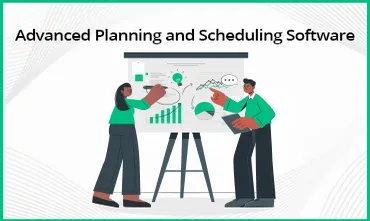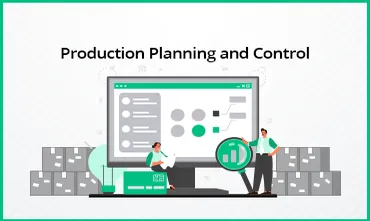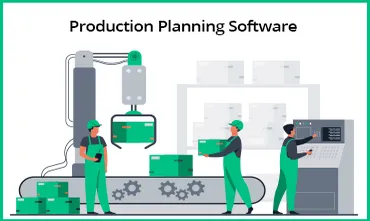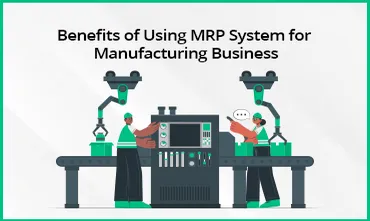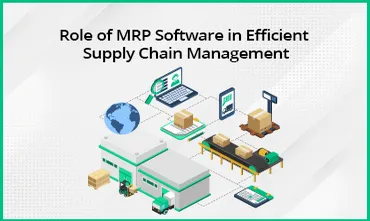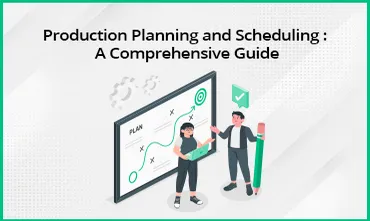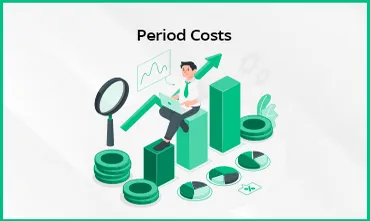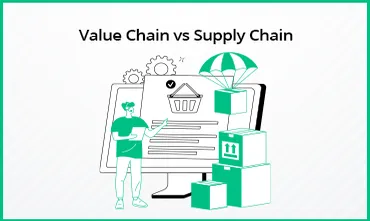Material Requirements Planning (MRP) is a system used in manufacturing to manage the purchasing and scheduling of raw materials and components. It is a key aspect of production planning and inventory control, and is essential for ensuring that materials are available when needed to keep production running smoothly. In this blog, we will explore the basics of MRP, including its key components and how it is used in manufacturing operations. We will also discuss the benefits of MRP and its role in helping companies improve their bottom line. Whether you are new to MRP or have experience with it, this blog will provide valuable insights and information to help you better understand and utilize this important system.
What Is Material Requirements Planning (MRP)?
Material Requirements Planning (MRP) is a production planning and inventory control system used to manage manufacturing processes. It is used to determine the demand for raw materials and components, and then schedules their production and delivery. MRP systems take into account factors such as lead times, inventory levels, and production capacity to optimize the manufacturing process and ensure that materials and components are available when they are needed. This helps manufacturers to reduce inventory costs and improve overall efficiency.
The goal of MRP is to optimize the use of materials and reduce inventory levels, while still meeting production demands. To do this, MRP systems use a variety of inputs, including sales forecasts, production schedules, and inventory levels, to generate detailed plans for the procurement and use of materials. These plans are then used to create purchase orders, production orders, and other necessary documents.
MRP systems are typically integrated with other business systems, such as enterprise resource planning (ERP) systems, to provide a comprehensive view of the organization's materials and production needs. They can also be used to track the progress of production orders, monitor inventory levels, and identify potential issues or bottlenecks in the production process.
Overall, MRP is a crucial tool for manufacturing organizations, helping them to optimize their use of materials and resources, reduce costs, and improve efficiency and productivity.
Why Is MRP Important?
In the same way that planning is essential for an individual to facilitate one's day-to-day routines productively, material requirements planning is important to ensure productivity in companies.
The importance of material requirements planning is reinforced by the cost and efficiency value it provides to the various manufacturing departments of a company. Manufacturing operations become significantly more productive, adaptable, and profitable by using MRP.
This is possible because MRP systems offer a standard platform for enterprises to enable improved oversight over material movement, and ensure customer orders are met, from original quote stage until shipment with ease.
You can also integrate production and inventory functions of your business with the MRP, to detect inventory stock-outs and upcoming production problems quickly, while optimizing costs and time.
How Does Material Requirements Planning (MRP) Work?
A material requirements planning process uses Bill of Material (BOM) to capture the required data. BOM is a hierarchical list that includes details such as all the materials, subassemblies, and other parts required to manufacture a product, along with their quantities.
Once the system has all the required data, it then identifies the dependent components of the raw material required to produce the final output. For instance, when it comes to producing a pen, the ink refill, body of the pen, and cap must be in place to manufacture the pen as a complete product. The mere availability of the ink refill won't produce the final output, the pen.
To simplify further, the MRP system identifies which parts of the raw materials are interdependent, and the final product cannot be produced until all of these component parts are assembled. This connectivity between the parts of the finished goods, or two different components of raw material, helps to calculate the total number of items needed for production.
As a manufacturer, you can assess how much to produce after considering the number of confirmed orders, market circumstances, previous sales performance, and similar factors to establish a forecast. These factors help you to estimate how much to produce to satisfy the anticipated demand, enable you to match supply with demand accurately and level up with customer demands.
MRP Steps And Processes
Let us take you through the detailed process of material requirements planning to help understand the value and ease it brings to your manufacturing business.
The process of material requirements planning starts with taking inventory of the existing raw materials in hand. The next step involves identifying what other raw materials will be required to meet the end goal of customer orders. Following which, procurement is done, where you need to procure and source the raw material. Let's know more about the MRP steps and processes in detail:
Inventory tracking
This stage involves calculation of the existing stock quantity within the manufacturing unit. The system determines net requirements for all planned orders by analyzing expected independent requirements and material reservations. Incoming sales orders are compared with available warehouse stock and anticipated receipts from purchasing and production departments.
Once all the data has been captured, the system generates procurement proposals when a material shortfall is identified. This is in case the current stock amount (including confirmed receipts) is less than what is needed.
Identifying the demand for raw materials
In this step, the total requirement for raw materials is calculated by considering the total demand for the finished products, or orders placed by the buyers.
Additional requirements (unplanned goods issues and excessive component consumption in production) can be met using the material prediction functionality in MRP. This prediction is built on prior estimates of unforeseen needs, and assessed with precise requirement amounts.
Procurement Planning
This step determines the time intervals in which you should place orders for raw materials and what should be the optimal cost for it. This is done by computing the delivery and release dates for materials obtained externally, and the production dates for goods created internally.
MRP Inputs
Knowing your production plan, the inventory of raw materials at hand, and interconnectivity of raw materials helps the MRP system to conclude how much raw material is required and in what intervals of time it is required.
These input functions of material requirements planning are explained in detail below:
-
Master Production Schedule: This process outlines the end-to-end planning of your production cycle. It highlights the total demand, along with insight on how much you plan to produce, in order to meet the demand.
-
Inventory Status File (ISF): It displays the current status of the inventory available, and how much more stock is required to meet the demand.
-
Bill of Material (BOM): It's the principal document based on which the dependency of raw materials is calculated. It includes details of two types of inventory items: independent demand and dependent demand.
MRP Outputs
Your production unit may use several outputs from the material requirements planning program. These include:
-
Order release notice, used to place orders that the MRP system has planned.
-
Reports outlining anticipated orders for release in upcoming timeframes.
-
Notices of rescheduling, with modifications to the deadlines for open orders or orders placed by the customers that are yet to be fulfilled.
-
Cancellation messages noting that open orders have been canceled due to modifications to the master schedule.
-
Inventory status reports wherein the MRP system is integrated with the inventory module. This helps to know current inventory availability and plan purchases and production accordingly.
MRP in Manufacturing
Manufacturing companies need to ensure efficient and cost-effective internal processes, in order to meet customer demands with high quality products. Some SMEs are unable to do this, mainly because they lack the necessary tools when it comes to managing and planning raw material requirements and components. An expert MRP tool can solve this problem.
MRP defines accurate material requirements based on production demand, by assessing existing stock availability and purchase coordination. It streamlines manufacturing processes with timely projection, allocation and calculation of materials. And also supervises the complete process to ensure timelines are met without errors.
It integrates key business operations, and helps improve the efficiency and predictability of all stages of production. This is done by eliminating uncertainty surrounding inventory and reducing the time required to manage it. These advantages enable manufacturing companies to become more profitable and scale steadily!
Benefits of Material Requirements Planning (MRP)
Material Requirements Planning ensures that product quality is consistent, and keeps material and labor costs as low as possible. In addition to this, let's look at more benefits of MRP for your business:
Purchase planning
By providing precise amounts of input materials and other resources, MRP can help you organize purchasing and reordering processes efficiently.
Product planning
Based on the master production schedule, inventory status file, and bill of material, the MRP system calculates how many units of finished goods are to be produced. This ensures that you don't produce less or extra quantities than what is required.
Inventory planning
Accurate raw material requirement calculated by the MRP process makes inventory planning easier for you. It helps reduce the risk of stock-outs and ensures customer satisfaction, sales, and revenue are not negatively impacted due to mismanaged inventory processes.
Cost reduction
By eliminating inefficiencies in material planning, inventory and production planning, MRP ensures reduction of costs in manufacturing operations. Since all necessary materials and components are available when they are required for the production process, impromptu costs due to delays and material shortage are also easily avoided.
In this way, MRP increases labor productivity and reduces lead time for customers for improved customer satisfaction. With precise material planning and scheduling, SMEs can gain a significant competitive advantage in the market.
History of MRP
Before the adoption of material requirements planning, manufacturing companies used the reorder point, reorder quantity and economic order quantity methodologies for planning materials and inventory management. They needed a centralized system to accommodate all of their requirements.
It was during the 1950s, that a method known as material requirements planning began to emerge. Since then, it has grown to become the fundamental system for organizing material and components for a business, in alignment with inventory management and production demands.
Over the decades, MRP systems have witnessed several developments based on unique business needs and industry-specific demands. Many literature and case studies have contributed to the evolution of MRP.
One of these is the book 'Material Requirements Planning - The New Way of Life in Production and Inventory Management,' written by Mr. Joseph Orlicky. This book is known to serve as the basis for businesses to learn about MRP and discover more about the use of MRP methods.
MRP vs ERP
Before we understand key differences between MRP and ERP or Enterprise Resource Planning, let's briefly understand how the term ERP came into existence.
After Mr. Orlicky's book, Mr. Oliver Wight further expanded MRP to Manufacturing Resource Planning (MRP II). It widened the scope of material requirements planning to include financials and added processes of product design, capacity planning, cost management, shop floor control and more.
Later in the year 1990, global analyst company Gartner coined the ERP term to include additional key business operations like inventory, production, accounting, human resources, and supply chain management along with MRP II.
Here are some important differences between MRP and ERP:
-
ERP systems assist with planning and automating of end-to-end business processes, while MRP systems mainly handle planning of material allocation for production.
-
The ERP system includes functions such as production, sales, purchases, accounting, manufacturing, supply chain, customer management, quality, processes, and planning. Therefore, it demands collaboration with the staff of the entire enterprise. On the other hand, since material requirement planning has a more restricted scope of ordering and planning materials, it primarily informs inventory and production related teams.
-
Based on their respective scope, ERP systems offer integrated solutions, also including MRP. However, MRP systems can be standalone solutions catering only to material planning functionalities.
TranZact - Best MRP Software
MRP module is a one-stop solution for manufacturing SME businesses. It integrates MRP with all related functions including sales, quotations, purchases, inventory and production.
An efficient cross-functional integration as this enables it to fetch important information from all departments, and provide real-time updates on material availability and requirements. This ensures optimized inventory, purchase planning and uninterrupted production cycles.
Based on data from sales orders, planned production orders, and finished goods, it offers a quick overview of how much material exists in stock, how much is blocked for production processes, how much is already ordered and how much is pending to order.
With TranZact's intelligent MRP and inventory reports, SME business owners can get a complete view of raw material needs, as per current stock and already placed purchase orders in a single click. This greatly helps to lower inventory costs, reduces excess stock, and ultimately helps to avoid order delays. TranZact is trusted by 10,000+ Indian SME Manufacturing companies. So, upgrade your business with its MRP functions and manage your material function with ease!
FAQs on Material Requirements Planning
1. What do you mean by MRP?
MRP stands for Material Requirements Planning. It is an inventory management and production planning system that helps organizations determine the amount and timing of materials needed to fulfill production requirements.
2. How does MRP benefit a business?
There are several benefits of MRP or material requirements planning for an SME manufacturing business. An automated MRP engine supports businesses in identifying material needs, corresponding quantities, and time schedules for the material requirements. MRP helps businesses streamline production and procurement processes to meet customer demands and improve overall productivity.
3. What are the key features of MRP software?
The following are important features of material requirements planning software:
- It offers real-time insight into material availability to plan purchases accurately.
- Collaboration with inventory management and control, to ensure timely fulfillment of customer demand.
- Data availability of planned production cycles within the MRP system helps to know how many units of finished goods are to be produced.
- Integration with other supply chain management modules within the company enables the smooth flow of goods and services from the quotation stage to shipment.
4. What are the objectives of MRP?
The key objectives of MRP are to improve operational efficiency, reduce costs, and enhance customer satisfaction by ensuring the availability of materials for production in a timely and cost-effective manner.
5. What are the 3 main inputs of MRP?
The three main inputs of MRP are the bill of materials (BOM), which lists the components and quantities needed for production, the master production schedule (MPS), which defines the production requirements and timing, and the inventory status records, which provides information on current inventory levels of materials and finished goods.
6. What are the MRP challenges?
The challenges associated with MRP include data accuracy and integrity, as inaccurate or incomplete data can lead to planning errors and inefficient inventory management. Additionally, MRP systems can face challenges related to demand forecasting accuracy and variability, which may result in stockouts or excess inventory.




